This may or may not be what you were thinking. The Luxos from B&M is the hot new light on the market this summer, and for good reason. Higher output, wider beam, and remote switching and USB charger on the Luxos U what is not to like? There have been
plenty of posts and videos on other sites comparing the beam shots of these as well as others. The one thing everybody mentions is that the Luxos is significantly larger than the B&M Cyo. While I was shooting some product photos today it crossed my mind that I had both lights in the workshop, and should makes some comparison shots.


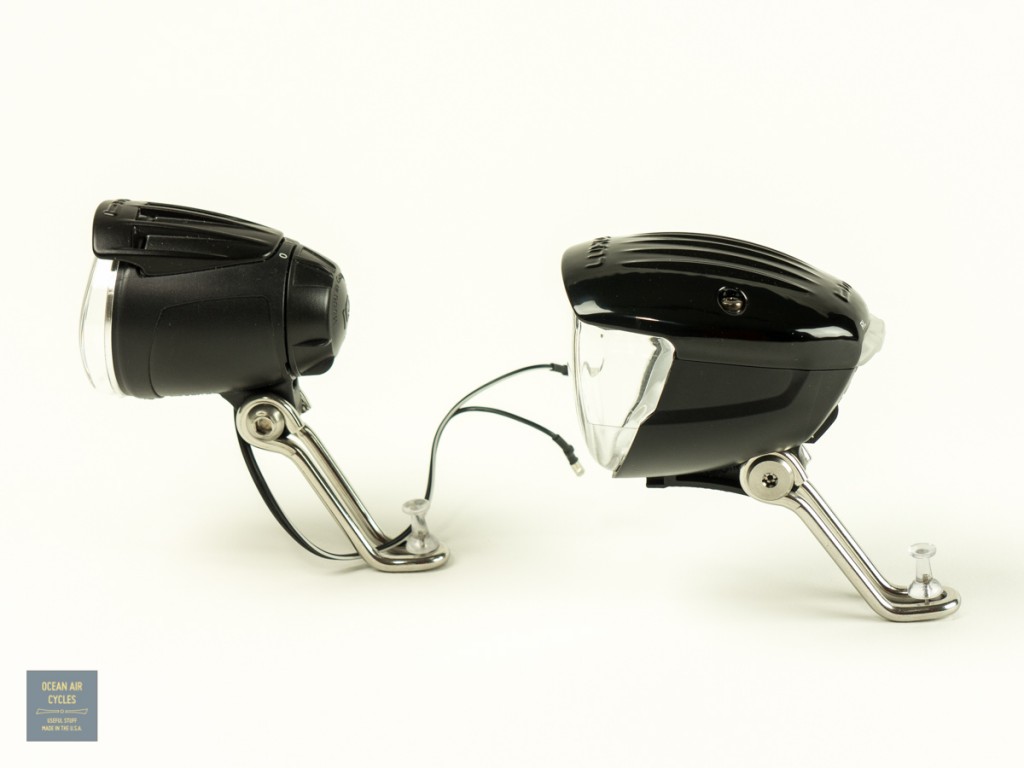

All that extra light comes with a slight price, and I am not talking about the $$ alone. The form factor and heat sink to cool the LED are significantly larger than the Cyo. The luxos is obviously a bigger light, and hits the scales with an extra 50g. That said, I am excited to get my
Rambler wired up with one. The extra light on the road, both to the front and sides will be welcome.
Dimensional Differences for mounting considerations:

I have a couple extra of the Luxos B and U in stock and will be adding them to the
storefront later this week.
I have been riding flat, non retaining system, pedals for a long time. Most of my youth, and for recent years thanks to Grant at
Rivendell, I have been pedaling free. There are a variety of options at the full range of price points. At the lower end you can get very basic touring or BMX pedals with decent traction for $20. The upper end is dominated by very thin machined aluminum mountain bike race pedals these go well up into the $hundreds with exotic materials in the pursuit of weight savings and thinness. I have been testing a range off offerings in pursuit of offering a pedal that strikes a balance of performance and value.
What are things I consider key?
- Wide and long platform for maximum foot support. This puts much of the stiffness burden back on the pedal and reduces or completely removes the need for stiffness in the shoe.
- Traction pins that are integral to the design, easily replaceable and in useful places. The pins keep you foot from slipping off of the pedal. There are lots of types, from cast in to screws that come in from the top or bottom.
- Sealed Cartridge bearings. This is where the price can go up fast compared to basic pedals. While most pedals can be serviced and last a life time, good seals and bearings increase the time between servicing as well as the ease of the process.
- Thinness. As downhill and dirt jumping have dominated this pedal market segment the pedals keep getting thinner. Older pedals are generally 25-30mm thick. The newest versions are 5-15mm thick. Thinner pedals get you closer to the ground. The change of center of gravity is probably insignificant, but you are 5-10mm closer to the ground and that helps to get more than the tip of your toe on the ground at a stop while your rear is still on the saddle. The truly ultra thin pedals generally make compromises in the bearing and spindle design to achieve the thinness.
Most pedals in this category are coming from overseas at this point in time. US made pedals are out there, but come at a high price and limited options. For now I have been looking at the imports.
The line that struck the best value when considering price and the above key elements was VP Components, and two pedals in particular the VP-001 and the Vice
[caption id="attachment_3667" align="aligncenter" width="640"]

Red VP001 and Blue VP Vice[/caption]
Both are good pedals for about $65-70 street price. Both are a bit wider than some other common pedals, MKS Grip King (lambda) and RMX "sneeker" pedals, as well as have more aggressive pins. The following comparison pictures tell the story.
[caption id="attachment_3669" align="aligncenter" width="640"]
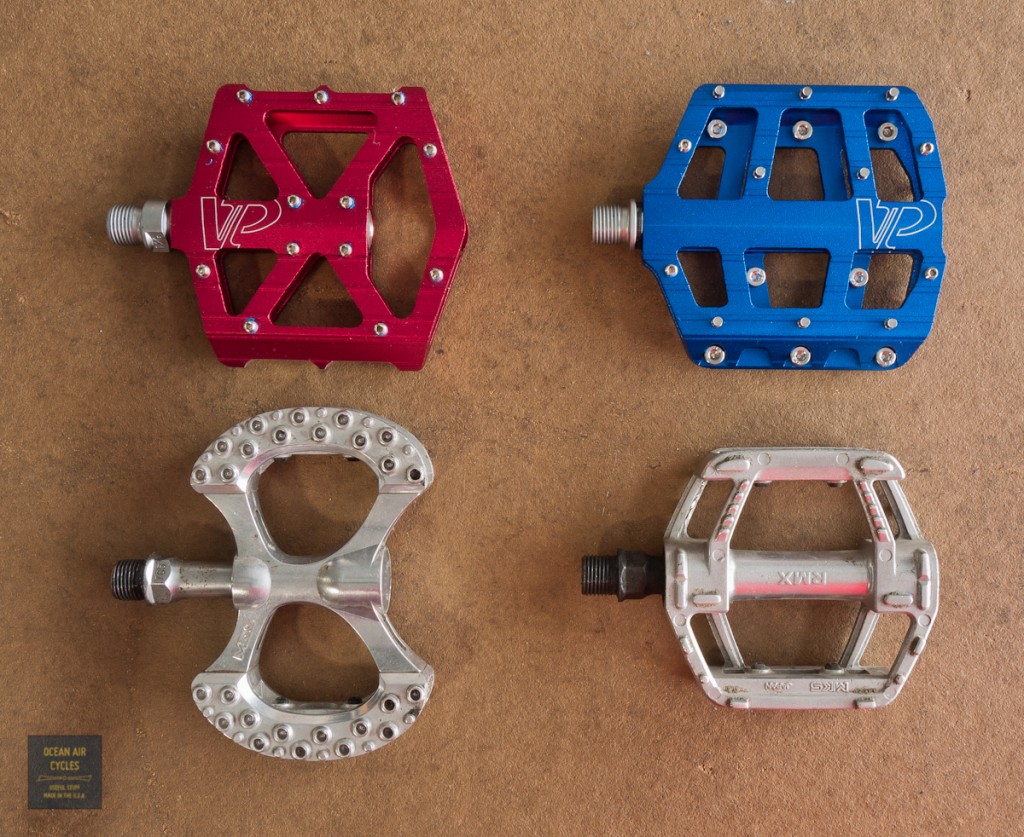
Red VP001 and Blue VP Vice[/caption]
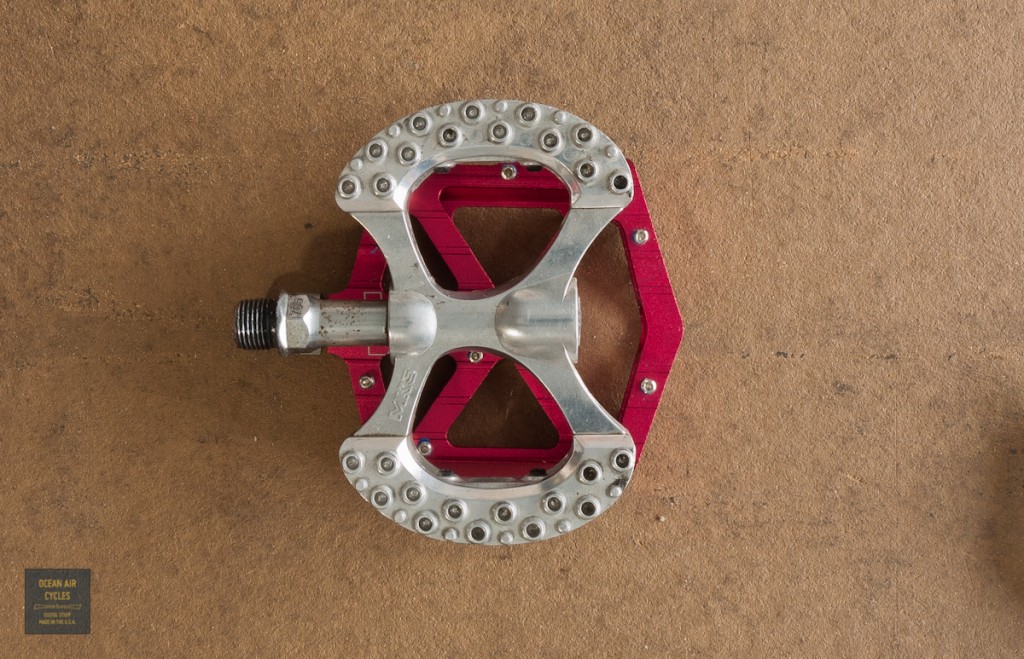
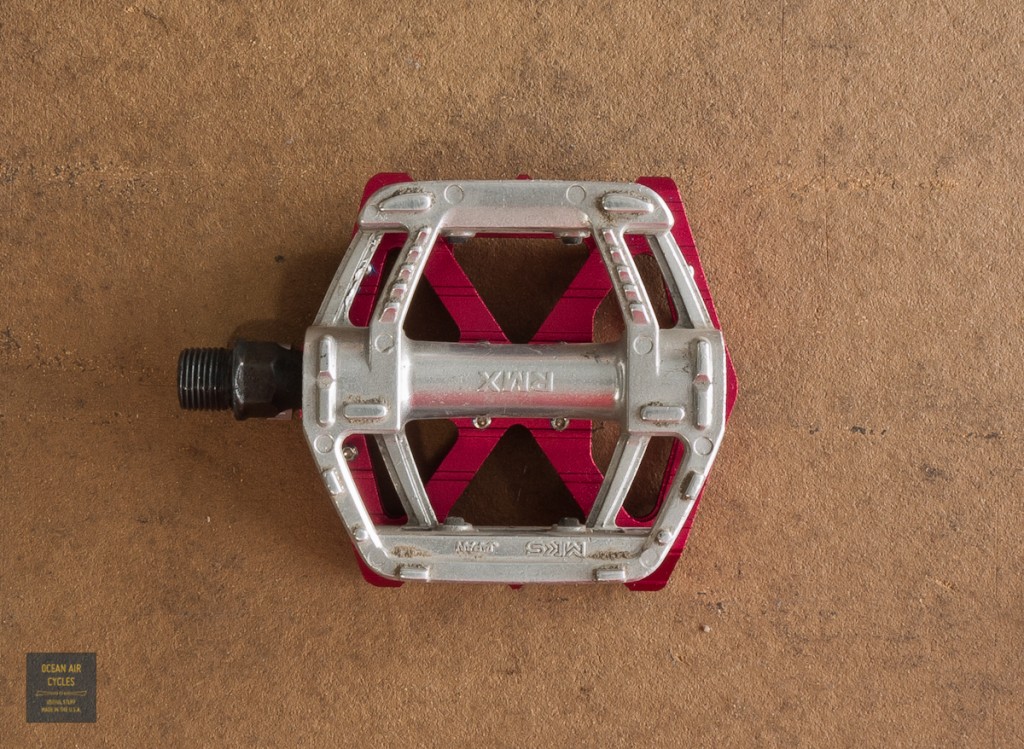

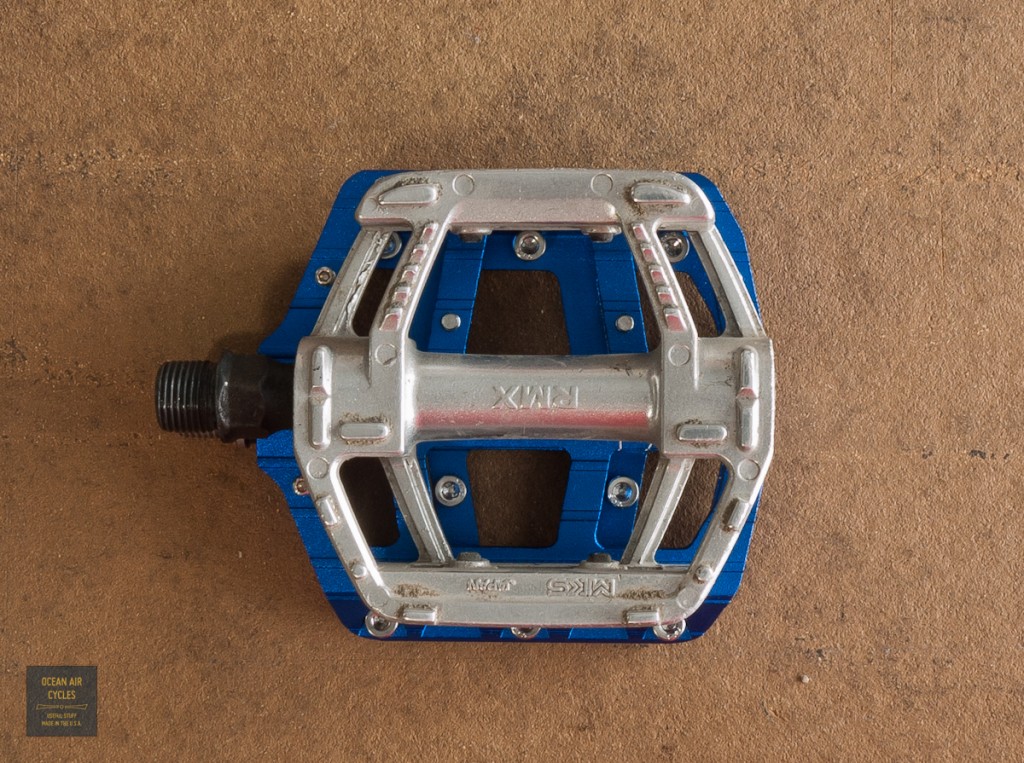 The difference in thinness is remarkable. The MKS pedals are 26mm while the VP are 16mm. The means your saddle height will come down 5mm and your toe will me 5mm closer to the ground at a stop without bringing the pedal any closer to the ground or threatening a strike.
The difference in thinness is remarkable. The MKS pedals are 26mm while the VP are 16mm. The means your saddle height will come down 5mm and your toe will me 5mm closer to the ground at a stop without bringing the pedal any closer to the ground or threatening a strike.
[caption id="attachment_3682" align="aligncenter" width="640"]

Red VP001 and Blue VP Vice[/caption]
There are also some subtle but important differences between the VP-001 and the Vice. For me the Vise is the clear winner. The VP-001 has a more traditional spindle that allows the pedal to be installed with a 6mm allen wrench or traditional 15mm pedal wrench. The Vise on the other hand requires a 8mm key. Why the difference? The vice allows the whole platform to sit closer to the crank arm, and thus your foot closer reducing the overall Q-factor. Q is the distance between crank arms, narrower Q generally feels more normal, and is used in traditional road biking designs.
[caption id="attachment_3668" align="aligncenter" width="640"]
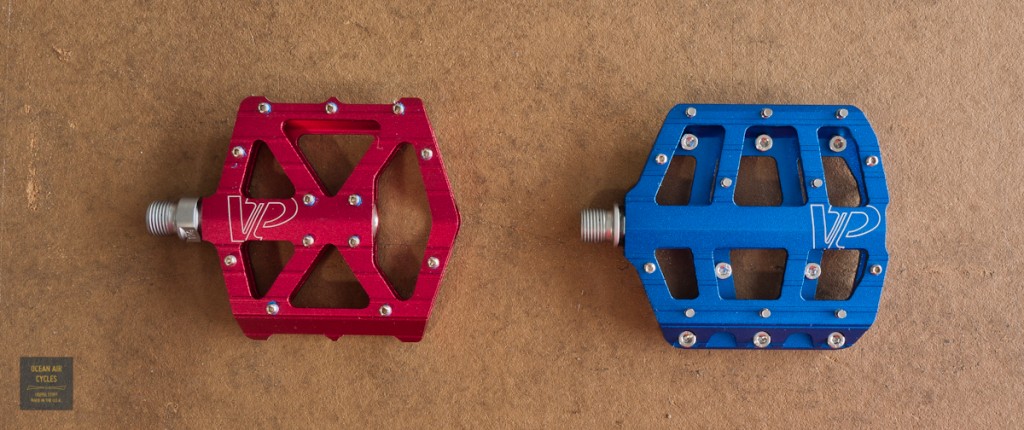
Red VP001 and Blue VP Vice[/caption]
The platforms are both quite large compared to traditional pedals. Compared to each other the Vice has more supporting area at the outer corners as well as through the center of the platform.
[caption id="attachment_3670" align="aligncenter" width="640"]

Red VP001 and Blue VP Vice[/caption]
[caption id="attachment_3671" align="aligncenter" width="640"]
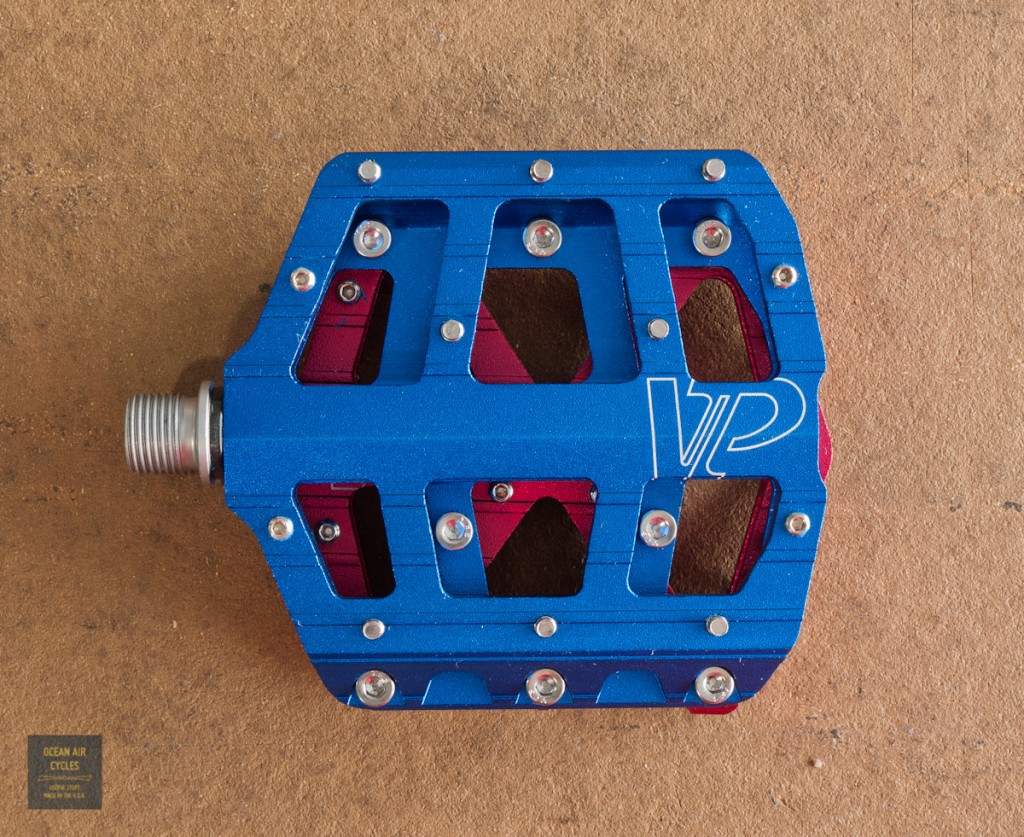
Red VP001 and Blue VP Vice[/caption]
The axle on the Vice is longer and the outboard bearing is placed a full 2cm further out board from the crank arm. This will reduce the loading on the bearing reducing wear and time between service.
[caption id="attachment_3678" align="aligncenter" width="640"]

Red VP001 and Blue VP Vice[/caption]

The last and a notable difference is the type and placement of the pins. The VP-001 uses grub or set screws that are inserted from the top. The hole for the wrench to remove and replace these can clog with crud and or be damaged from impact increasing the difficulty of replacement. The Vice uses a combination of M4 bolts that come in from the underside of the platform and the above mentioned grub screws. You can get rid of the grub screws and still have plenty of traction for touring and road riding. The M4 bolts allow a better platform for replacement or tinkering with different lengths etc. The stock M4 bolts are custom ground into pins,
replacements are available, but an average M4 bolt from the store will work fine.

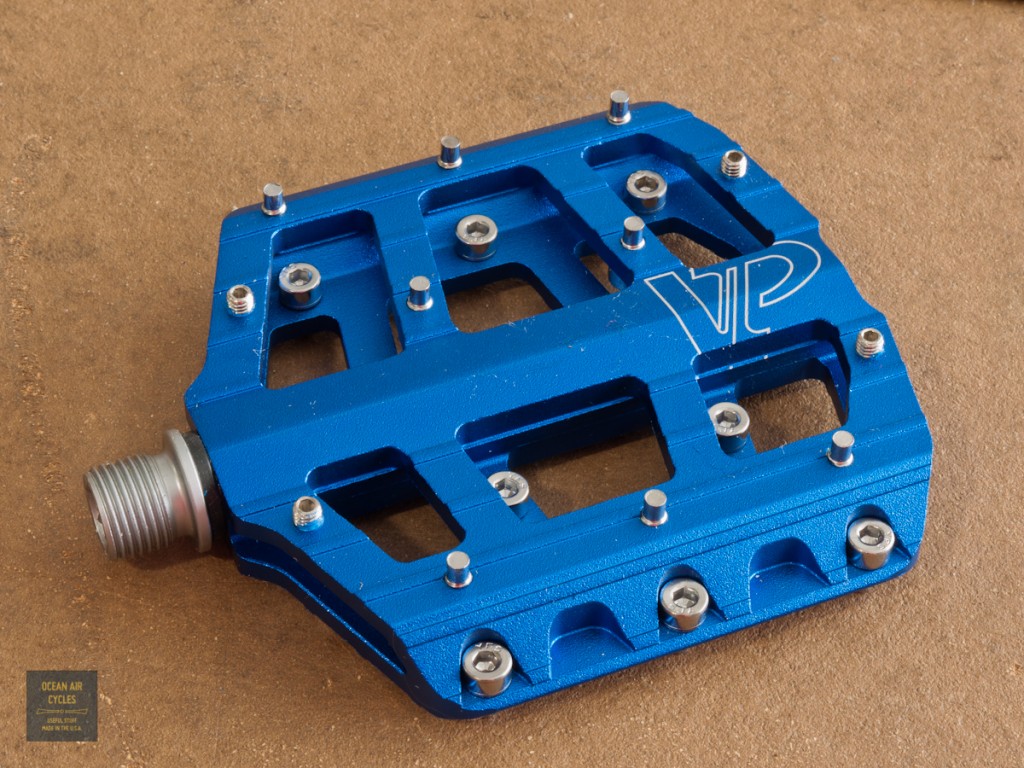
The things that I see as improvements in the Vice over the 001 do come at a price. The Vice is 28-30g heavier per pedal and the price is $5 more. For the truly weight conscious there are
Ti replacement spindles that will shave 35g per pedal. Fine tuning the pins could sheave even more. While both pedals are well overbuilt for street riding and touring, the added value of the Vice makes it the standout in my mind.
Bottom Line....I have been loving my pair of vices, plan on riding the heck out of them for a long time and will be adding the Vice pedals to the storefront this afternoon.
Ride free in the shoes that you like to walk in, it makes it more fun to ride to the places you are going during the day. The change in riding speed really is insignificant from the majority of us, and did I mention that you are likely to have more FUN?
Earlier this week I landed a Brooks Swift in trade for a B17 I had on a bike that sees only occasional use. This presented me with the opportunity to take some side by side comparison shots. The pictures tell a good bit of the story (L toR Berthoud Touring, Brooks B17 and Brooks Swift:
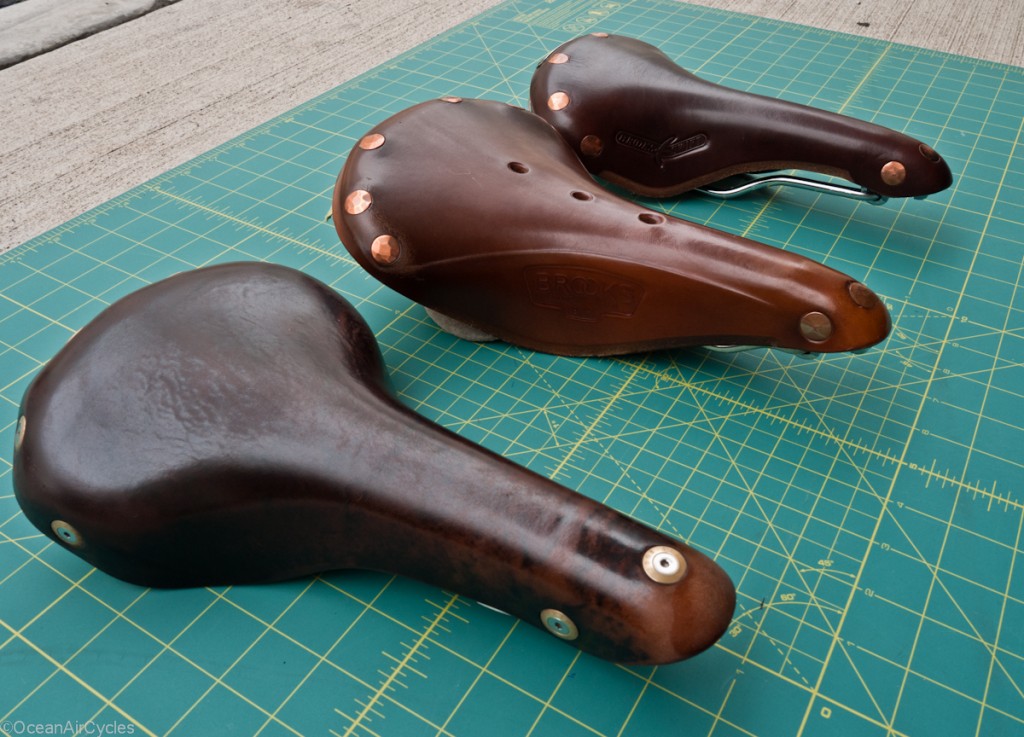
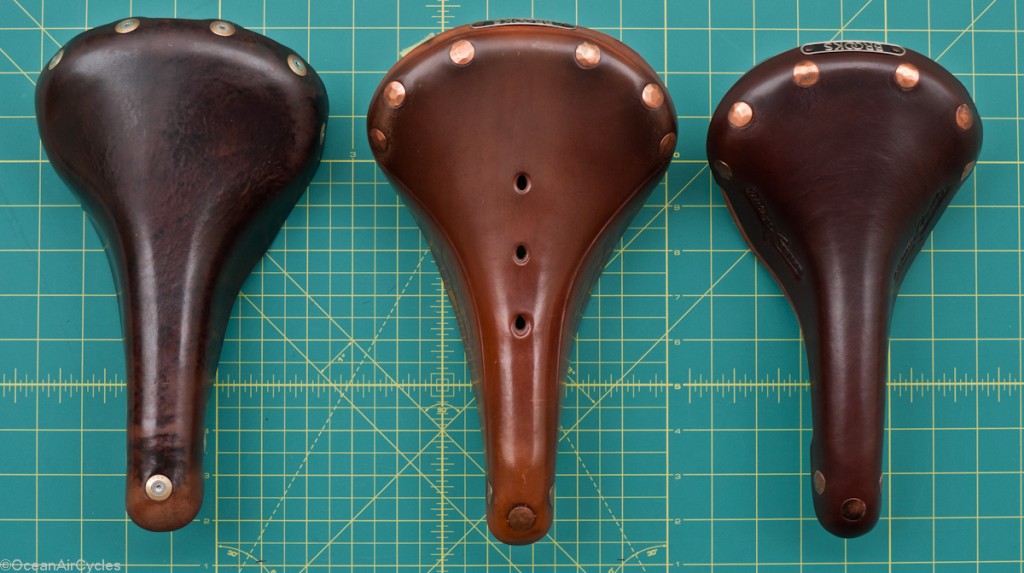


The Bi7 is a few years old with about 7K miles on it. The Berthoud is now two years old with about 5k miles on it, and the Swift is fresh out of the box. All three saddles have a similar plan shape that I prefer, the relatively wide flat rear with a quick drop and taper through the nose of the saddle. I am pretty big at 6'3" and 210 lbs, and the wider saddles provide adequate support for my sit bones while the arrow nose reduces the chance for thigh rub. Also, all three saddles have steel rails. While the general shape is similar, the overall dimensions vary as shown:
| Saddle |
Weight (g) |
Length (mm) |
Width (mm) |
| Berthoud Touring |
509 |
278 |
158 |
| Brooks B17 |
557 |
285 |
170 |
| Brooks Swift |
504 |
273 |
153 |
The one thing that the stats do not clearly indicate is the flatness of the rear portion, or more exactly the way the flatness drops off outside of the four central rivets. The B17 and the Berthoud both remain flat almost to the outer edge of the saddle. The Swift while flat in the center, drops off in a taper towards the front and sides, leading to a much narrower fit than the dimension may let on.
In the picture showing the rails, I lined all three up with the forward most point of rail mountablity in the same position. When on my bikes all three are pushed back as far as they can go. With this position my sit bones hit just forward of the second rivets from center. Thus while there is some variation in length of the rails on the three different saddles it is kind of moot point for how I have them on the bike.
While I have only logged 50 miles or so on the Swift I can say that I love all three equally but different. The B17 is perfect on bike where the bars are at or above saddle height. The wider rear better accommodates the wider stance of my sit bones when in a more upright position. I also find that the B17 is much more comfortable with thinner shorts and a chamois adds more bulk than is needed. The Swift is more suited to bikes where the bars are below saddle height. The narrower contact patch adequately supports my sit bones with my torso rolled forward, yet the drop off at the corners and narrow nose keep the pressure off of places where you do not want it. So far I have only ridden the Swift with my Ibex knickers that have a chamois, but based on my initial impressions I look forward to this saddle when things warm up a bit and I get back to my normal shorts. The Berthoud is my Goldilocks saddle. I have had it on every bike in the garage, bars high or low it was comfortable. The sweet spot was with the bars at saddle height on the Roadeo. I am hoping that with some break in the Swift will be as comfortable.
The Swift is on the Roadeo for break in and experimenting with the bars set below the saddle. I am looking forward to putting the miles in with this one.
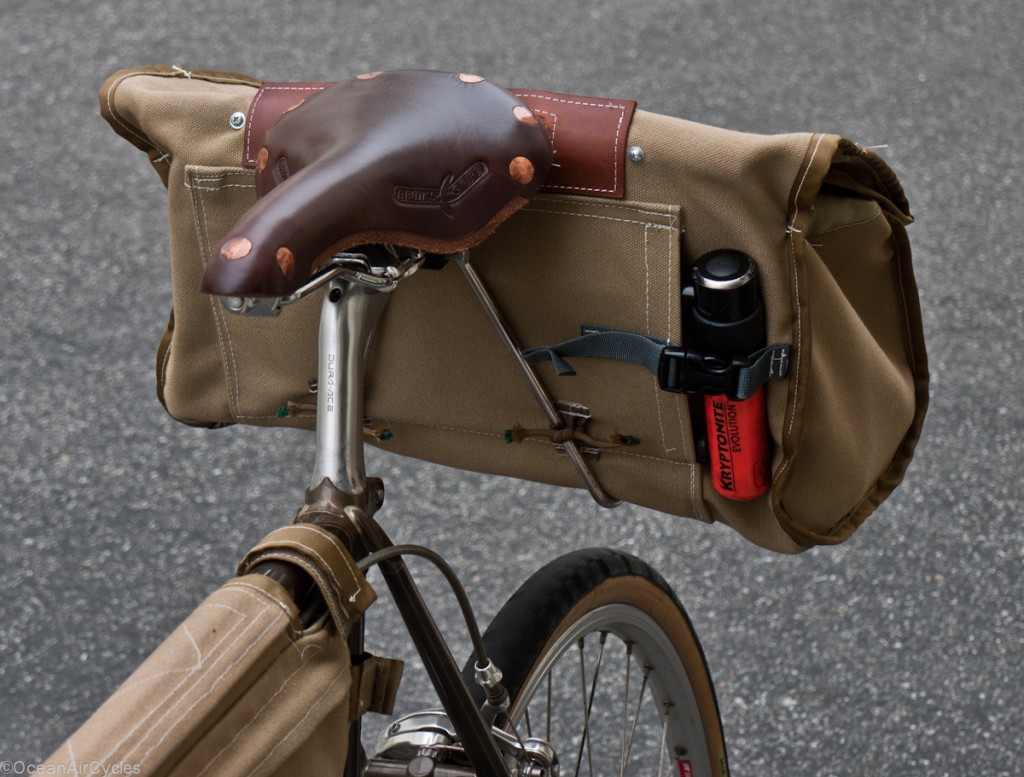



 All that extra light comes with a slight price, and I am not talking about the $$ alone. The form factor and heat sink to cool the LED are significantly larger than the Cyo. The luxos is obviously a bigger light, and hits the scales with an extra 50g. That said, I am excited to get my Rambler wired up with one. The extra light on the road, both to the front and sides will be welcome.
Dimensional Differences for mounting considerations:
I have a couple extra of the Luxos B and U in stock and will be adding them to the storefront later this week.
All that extra light comes with a slight price, and I am not talking about the $$ alone. The form factor and heat sink to cool the LED are significantly larger than the Cyo. The luxos is obviously a bigger light, and hits the scales with an extra 50g. That said, I am excited to get my Rambler wired up with one. The extra light on the road, both to the front and sides will be welcome.
Dimensional Differences for mounting considerations:
I have a couple extra of the Luxos B and U in stock and will be adding them to the storefront later this week.



















